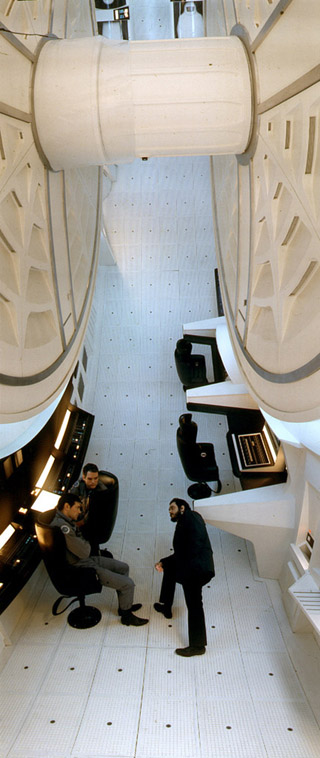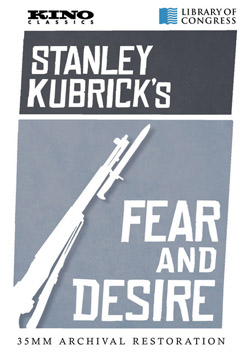“Since his death in 1999, Stanley Kubrick has enjoyed an acclaimed afterlife,” writes Steve Erickson for the Atlantic. “2001: A Space Odyssey this year placed at No. 6 in Sight & Sound magazine’s once-a-decade poll of film critics’ favorites—making it the youngest film in the top 10. Rodney Ascher‘s excellent documentary Room 237, which will be released next spring, offers five obsessive fans of The Shining a platform to deliver their rather questionable interpretations of the film. A Clockwork Orange seemed as beloved as ever when it turned 40 in February.”
Stanley Kubrick, the exhibition originally organized and presented in 2004 by the Deutsches Filmmuseum in Frankfurt (in cooperation with the Deutsches Architektur Museum and Jan Harlan, Kubrick’s brother-in-law and executive producer on a good handful of his movies), has been through Berlin, Melbourne, Ghent, Zurich, Rome, Paris, Amsterdam—and now, Los Angeles. As David Ng reports in the Los Angeles Times, the impetus for bringing the show to the Los Angeles County Museum of Art “came in large part from Terry Semel, a former Warner Bros. executive and current co-chairman of the LACMA Board of Trustees. The studio worked with Kubrick for nearly three decades, starting with A Clockwork Orange in 1971 and ending with Eyes Wide Shut, released four months after Kubrick’s death in 1999, at age 70.” Semel: “I saw the show in Europe. I thought it was nice but it could be delivered in a more exciting way.”
Ng: “For the Kubrick show’s U.S. debut, LACMA has reconfigured the layout of the previous exhibition, adding a new video montage of his movies as well as some new archival material. The most significant change is an emphasis on Kubrick as a visual artist, with his films placed in the context of an art museum. The exhibition highlights scenes in his movies that were directly influenced by works of art—the spectral twins in The Shining [1980] that were inspired by the photographs of Diane Arbus, and numerous shots in Barry Lyndon [1975] that were based directly on 18th century paintings by Thomas Gainsborough, William Hogarth, George Stubbs and others.”
The exhibition, which opens tomorrow and runs through June 30, 2013, will be accompanied by a screening series, 2012: A Kubrick Odyssey, which launches on November 7 with An Academy Salute to Stanley Kubrick, an evening of clips and remembrances hosted by Malcolm McDowell. Film Independent at LACMA curator Elvis Mitchell, writing about the “Art and Myth of Stanley Kubrick,” notes that he finds he has “a special affinity for Stanley Kubrick’s black-and-white films. There’s an unspoken carnality to them, possibly because they have the silvery shimmer of gelatin prints, luminescent and hot, and the actors give off a satiny glow that’s less painterly and far more vivid than in Kubrick’s color work. The luscious women, in particular, all of whom suggest cigarette girls or dancers, have a comprehension of their power that’s almost precognitive. You can easily go from one of the young women in Kubrick’s early photographs for Look magazine, which helped establish his name, to Sue Lyons’s simmering performance as the title character in Lolita [1962]—it’s a natural progression.”
One of these black-and-whites, Kubrick’s feature debut Fear and Desire (1953), screens on Friday, November 9, and is also now out on DVD and Blu-ray from Kino Lorber. Dennis Lim in the LAT: “Unseen for decades, it started to surface at festivals and revival theaters in the 1990s, at which point one especially scathing assessment declared it ‘a bumbling, amateur film exercise, written by a failed poet, crewed by a few friends, and a completely inept oddity, boring and pretentious.’ The source of that harsh judgment? Kubrick himself…. The stubbornly abstract story of four soldiers making their way through a forest behind enemy lines after a plane crash, the movie announces itself as an allegory. A grave opening voice-over explains that the conflict depicted in the film is ‘any war,’ taking place ‘outside history.’ It concludes: ‘These soldiers that you see keep our language and our time but have no other country but the mind.'”
At Slant, John Semley notes that Fear and Desire is set in “that ‘no-man’s land’ non-space between enemy lines in Paths of Glory, or even closer the ‘world of shit’ that Matthew Modine’s Pvt. Joker mentions in Full Metal Jacket: abstracted and absurd, bound only to its own topsy-turvy in-house logic. Like Impolex, Alex Ross Perry’s shoestring riff on Pynchon’s Gravity’s Rainbow, Kubrick’s impressive debut likewise transposes the iconography of war onto the psychic geography of the mind, less a continuous story than a sequence of Beckettian episodes…. Fear and Desire is Kubrick unfettered, for better or worse, a direct line into his own psychic geography and creative-intellectual landscapes.”
“If 1956’s The Killing set the scene for a visionary new director, Paths of Glory, released a year later confirms it.” William Friedkin has selected his top ten Criterion releases, and Paths is in at #7: “It is the darkest evocation of war ever filmed; you feel the pain, the fear and discomfort experienced by French soldiers engaged in a meaningless, suicidal battle with a faceless German enemy.”
The BFI is bringing a new digital transfer of The Shining to U.K. theaters, the full U.S. version, which runs 24 minutes longer than any version the Brits have yet seen. The Telegraph‘s Tim Robey: “British Shining fans will pounce on these additions, because committed acquaintance with this movie is a hunger that needs feeding, and there’s not really any imaginable version that’s quite long enough.”
In the video below, scenic artist Ron Punter, camera operator Kelvin Pike, camera technician Mick Mason, publicist Julian Senior, and June Randall, who oversaw continuity on The Shining, all discuss the making of the film Martin Scorsese has called “essentially unclassifiable, endlessly provocative, and profoundly disturbing.”
There’ll surely be more to collect here soon, but in the meantime, Brooke Hodge surveys the LACMA exhibition for the New York Times; and for Interview, Annette Insdorf discusses Kubrick with Terry Semel and Tom Cruise. Speaking of whom, Nicole Kidman looks back on the making of Eyes Wide Shut in the Hollywood Reporter.
And finally for now, an inexhaustible, ever-expanding resource. From Coudal Partners: “Stuff About Stanley Kubrick.”
Updates, 11/1: Doug Cummings previews the LACMA exhibition for the LA Weekly: “[I]t clarifies and enriches aspects of the filmmaker’s work for his fans while providing an encyclopedic introduction for the uninitiated…. Wandering through the exhibit, one is reminded of the filmmaker’s beloved tracking shots, which accompany protagonists through trenches, corridors and hedges, influenced by filmmaker Max Ophüls, whose death, the exhibit notes, Kubrick memorialized on the set of 1957’s Paths of Glory. Intensified by the filmmaker’s fondness for wide-angle lenses, they emphasize the singular travels of his protagonists moving through time and space. As a similarly slow-reveal sojourn, the engrossing exhibit… is an experience Angelenos won’t want to miss.”
The BFI’s Samuel Wigley talks with Jan Harlan, who began working with Kubrick on the director’s most famous unrealized project, Napolean. The focus of their conversation, though, is The Shining.
For news and tips throughout the day every day, follow @KeyframeDaily on Twitter and/or the RSS feed. Get Keyframe Daily in your inbox by signing in at fandor.com/daily.





